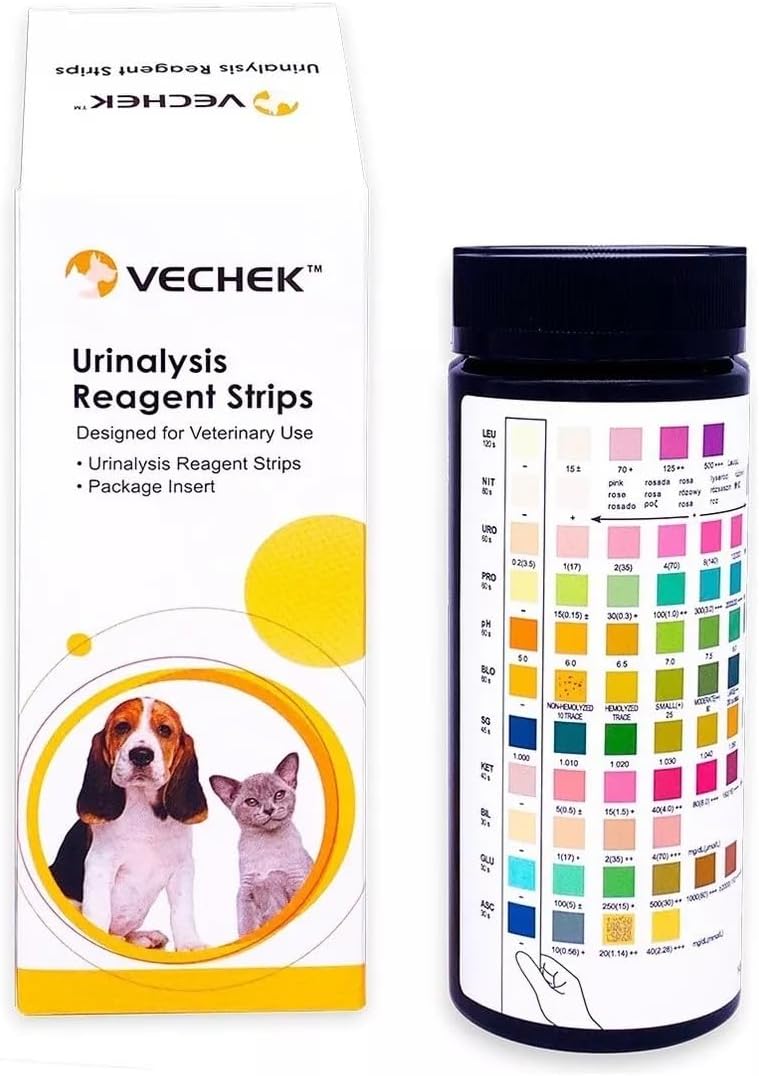Valuemed
VECHEK 11 Parameter Urine Test Strips For Vets And Pets URS Pot Of 25 Urine Strips
VECHEK 11 Parameter Urine Test Strips For Vets And Pets URS Pot Of 25 Urine Strips
Couldn't load pickup availability
VECHEK 11 parameter urine testing strips for Cats & Dogs
These veterinary grade urine test strips for both dogs, cats and other mammals give reliable and accurate results in just 60 seconds. These urine test strips can be used by professional veterinarians for conducting urine tests, and can also be used to conduct a comprehensive urine assessment of your pet at home.
Key features of the VECHEK URS11 urine test strips for vets and pets
- Simple, accurate and easy to use dip and read urine screening test strips suitable for cats, dogs and all large and small mammals.
- Great value 25 urine test strips per pack. Prevent waste as should be used within 3 months of opening
- Urine test strips for 11 parameter urinalysis ie 11 pad urine tests on each urine test strip for Veterinary urine health screening.
- Ideal urine test strips for Veterinary healthcare screening and disease monitoring,
- Give fast, accurate and reliable urine test results.
- Global Brand Urine testing strips manufactured by ALLTEST
- Boxed manufacturers pack with full instructions
- Long expiry date
- Instant results
Each VETERINARY test strip tests urine for the following 11 things:
- Glucose
- Ketones
- Specific Gravity
- Blood
- pH
- Protein
- Nitrite
- Bilirubin
- Urobilinogen
- Leucocytes (white blood cells)
- Ascorbic Acid
How to use the VECHEK 11 parameter urine test strips for pets
Directions For Use
- Allow the strip, urine specimen to reach room temperature (15-30ºC) prior to testing.
- Remove the strip from the closed canister and use it as soon as possible. Immediately close the canister tightly after removing the required number of strip(s).
- Completely immerse the reagent areas of the strip in fresh, well-mixed urine and immediately remove the strip to avoid dissolving the reagents. See illustration 1 below.
- While removing the strip from the urine, run the edge of the strip against the rim of the urine container to remove excess urine. Hold the strip in a horizontal position and bring the edge of the strip into contact with an absorbent material (e.g. a paper towel) to avoid mixing chemicals from adjacent reagent areas and/or soiling hands with urine. See illustration 2 below.
- Compare the reagent areas to the corresponding color blocks on the canister label at the specified times. Hold the strip close to the color blocks and match carefully. See illustration 3 below.
- Note: Results may be read up to 2 minutes after the specified times.
Share




Collapsible content
Can you send me a copy of the urine test strips instructions?
All the urine test strips we supply come with a detailed set of instructions for use. If you have lost your instructions and need a copy, you can either download them from the urine test strip product, or email our customer services team and ask them to email you a copy of the instructions.
Are human and dog urine test strips the same?
While both types of urine test strips are designed to analyse urine for various parameters, they are formulated to detect specific markers relevant to either humans or dogs.
Human urine test strips typically measure markers such as glucose, ketones, pH levels, protein, blood, and specific gravity. These parameters can provide insights into various health conditions in humans.
Dog urine test strips are specifically designed to assess the health of dogs. They may measure the same markers as human urine test strips such as glucose, ketones, pH levels, protein, blood, and specific gravity as well, but the reference ranges and the interpretation of the results can vary between species.
Are all urine test strips the same?
No, not all urine test strips are the same. Urine test strips, also known as urine dipsticks or urine reagent strips (URS for short), come in various types and are designed to measure different parameters in urine. The specific parameters that a urine test strip can detect depend on its intended use and the targeted analytes.
Common parameters measured by urine test strips include:
- pH level: Indicates the acidity or alkalinity of urine.
- Protein: Detects the presence of proteins in urine.
- Glucose: Measures the level of glucose (sugar) in urine.
- Ketones: Identifies the presence of ketone bodies, which may be elevated in conditions like diabetes or ketosis.
- Blood: Detects the presence of blood in urine, which may be a sign of various conditions.
- Specific gravity: Reflects the concentration of solutes in the urine.
- Leukocytes (white blood cells): Indicates the presence of inflammation or infection.
Different brands and types of urine test strips may have variations in sensitivity, accuracy, and the specific parameters they can detect. It's crucial to use the appropriate test strip for the desired purpose, whether it's for general health monitoring, diabetes management, or identifying potential urinary tract infections and to always follow the instructions provided with the urine test strips.
Urine test strips are also available to test for pregnancy , ovulation, female hormones that indicate menopause and for drugs and alcohol.
See all urine test strips available for sale online at Valuemed
Can I buy urine test strips over the counter?
Yes, urine test strips are often available over the counter at pharmacies, chemists, drugstores, and some retail stores. These urine test strips are commonly used for various purposes, such as monitoring general health, managing certain medical conditions (like diabetes), or conducting at-home pregnancy tests. You can typically find them in the health or pharmacy section of the store.
However, the availability of specific types of urine test strips may vary. For example, if you are looking for strips designed to measure glucose levels, ketones, or other specific parameters, you may need to check for strips that cater to those particular needs. Urine test strips are also widely available to buy online.
What indicates a urine infection on a dipstick?
A urine infection, also known as a urinary tract infection (UTI), can be indicated on a urine dipstick by certain abnormalities in the results. The following parameters on a urine dipstick may suggest the presence of a UTI:
- Leukocytes (White Blood Cells): An elevated level of leukocytes in the urine may indicate inflammation or infection in the urinary tract. Leukocytes are often a key marker for the presence of infection.
- Nitrites: Some bacteria, such as Escherichia coli (E. coli), which are common culprits in UTIs, can convert nitrate to nitrite. Detection of nitrites in the urine may suggest the presence of certain bacteria associated with urinary tract infections.
- Blood: Blood on a urine dipstick can be an indication of various conditions, and while it may suggest infection, it is not specific to infection alone. The presence of blood in the urine is called hematuria, and it can be caused by a range of factors.
If you notice abnormal results in these parameters, it's important to consult with a healthcare professional for further evaluation and confirmation of a urinary tract infection. A urine dipstick provides preliminary information, but additional diagnostic tests, such as a urine culture, may be needed for a more accurate diagnosis and identification of the specific bacteria causing the infection.
It's crucial not to self-diagnose or self-treat based solely on the results of a urine dipstick. A healthcare professional can provide appropriate guidance, recommend further tests if necessary, and prescribe antibiotics or other treatments if a urinary tract infection is confirmed.
What are the causes of blood detected on a urine dipstick?
The presence of blood in urine, known as hematuria, can be detected on a urine dipstick and may be caused by various factors.
Here are some common reasons why blood might be detected on a urine dipstick:
- Urinary Tract Infection (UTI): Infections in the urinary tract, including the bladder or kidneys, can lead to inflammation and bleeding, causing blood to be present in the urine.
- Kidney stones: The presence of kidney stones can cause irritation and damage to the urinary tract, resulting in blood in the urine.
- Bladder or kidney Infections: Infections specifically affecting the bladder or kidneys can lead to hematuria.
- Trauma or injury: Physical trauma to the urinary tract, such as a recent injury or surgery, can cause bleeding.
- Inflammation of the genito or urinary tract: Conditions like cystitis, which involve inflammation of the bladder, can lead to blood in the urine.
- Prostate disease: In men, problems with the prostate can sometimes cause bleeding during urination.
- Certain medications: Some medications may cause irritation and result in blood in the urine.
- Inherited conditions: Certain inherited disorders can lead to blood in the urine.
- Menstruation: it is important to remember that in women menstruation can sometimes give a false positive for blood on a urine test strip, as the blood is not coming from the urinary tract but from menstruation.
It's important to note that the presence of blood on a urine dipstick is a preliminary indication, and further evaluation is necessary to determine the underlying cause, and rule out any serious underlying conditions. If you notice blood in your urine or if a dipstick test suggests its presence, it's crucial to consult with a healthcare professional. Additional diagnostic tests, such as a urine culture, imaging studies, or a cystoscopy, may be needed to identify the cause of hematuria and determine the appropriate course of action.
Good timing
Good price, as described. Arrived on time. Would recomend.





